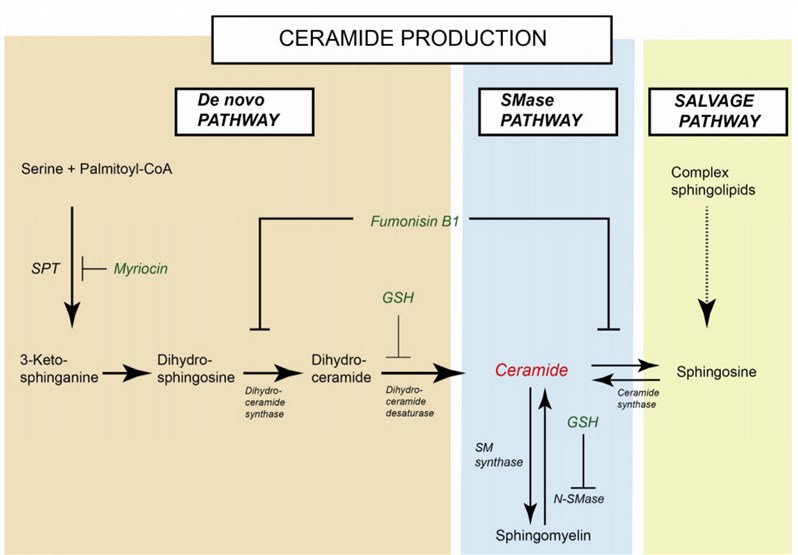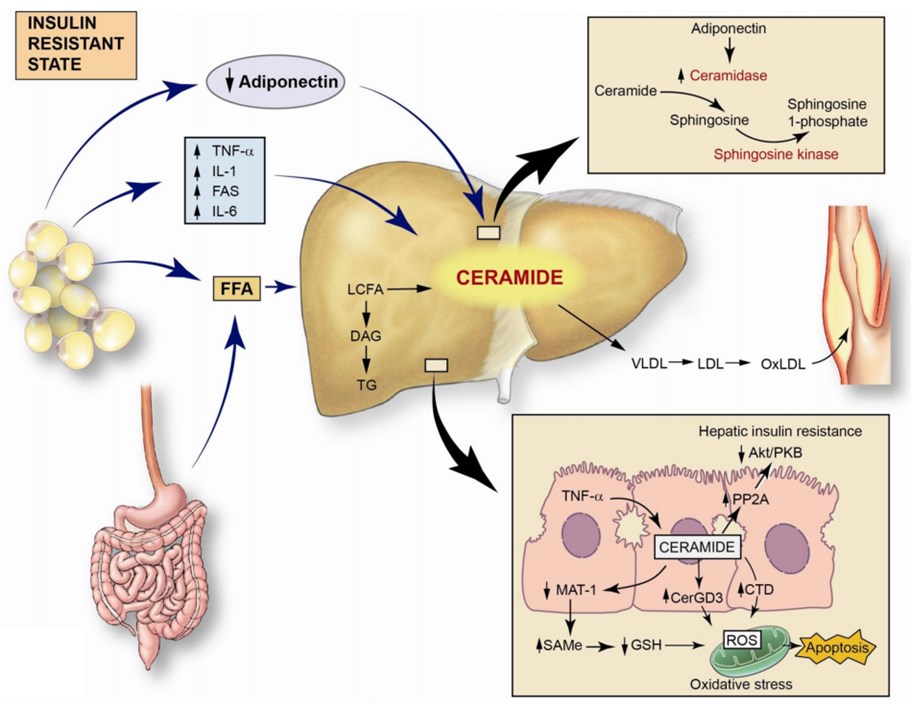NASH Target Development Service for Ceramide Depletion
Equipped with world-leading drug discovery platforms and professional scientific staff, Creative Biolabs is more than pleased to assist our clients with the most satisfactory non-alcoholic steatohepatitis (NASH) treatment services and related research services.
Introduction to Ceramide
Ceramides are a family of sphingolipids of lipid molecules, which consist of sphingosine and a fatty acid. Ceramides primarily concentrate within the cell membrane because they are components of major lipids in the lipid bilayer, sphingomyelin. Generally, ceramides can be synthesized by three major pathways: (i) sphingomyelinase pathway is essentially hydrolysis the sphingomyelin in the cell membrane into ceramides and phosphocholines by sphingomyelinase; (ii) de novo pathway synthesizes ceramides in the endoplasmic reticulum from palmitate and serine, which is catalyzed by serine palmitoyltransferase and ceramide synthase; (iii) salvage pathway mainly generates ceramides through breakdown of complex sphingolipids ultimately into sphingosines, which are re-acylated to form ceramides. Among these three pathways, the salvage pathway was estimated to contribute from 50% to 90% of sphingolipid biosynthesis. Ceramides play critical actions in a variety of physiological functions cellular regulations, such as signal transduction in apoptosis, cell differentiation, proliferation, senescence, migration, and adhesion. Ceramides homeostasis between ceramide synthesis and depletion plays a decisive role in maintaining body health.
 Fig.1 Ceramide biosynthesis through de novo, sphingomyolinase, and salvage pathways. (Pagadala, 2012)
Fig.1 Ceramide biosynthesis through de novo, sphingomyolinase, and salvage pathways. (Pagadala, 2012)
Ceramide Depletion in NASH Treatment
It has been suggested that ceramide abnormalities involve a number of pathological processes including tumors, neurodegeneration, insulin resistance, microbial pathogenesis, obesity, inflammation and so forth. As a kind of lipids, ceramides also devote to nonalcoholic fatty liver disease through several mechanisms. Properties such as insulin signaling inhibition, cell signaling regulatory, apoptosis, oxidative stress, and inflammation induction, enzymes activity in synthesis processes. All of these affect the accumulation of ceramide in the liver and thereby exerting subtle and important effects on the development of nonalcoholic fatty liver disease and progression to NASH. Based on this point, ceramide depletion may be a good treatment strategy for NASH.
Since synthesis reaction of ceramides involves several critical enzymes, alteration of enzymes activities to reduce ceramide production or increase ceramide depletion is a good choice for NASH treatment. Based on these factors and existing studies, we have investigated and developed several critical enzymes inhibitors/activators for NASH treatment, which include but not limited to:
- Acid Sphingomyelinase (ASMAs) Inhibitors
- Serine Palmitoyltransferase (SPT) Inhibitors
- Acid Ceraminidase Activators
 Fig.2 Potential role of ceramide in the development and progression of nonalcoholic fatty liver disease and related complications. (Pagadala, 2012)
Fig.2 Potential role of ceramide in the development and progression of nonalcoholic fatty liver disease and related complications. (Pagadala, 2012)
With a series of platforms (e.g. Hit to Lead, Lead Optimization, IND-Enabling, Target Identification, and Validation, Hit identification) and abundant background in target identification for drug discovery, Creative Biolabs provides a diverse portfolio of NASH treatment services including Biomarkers for NASH Diagnosis, Target Discovery and Therapeutic Strategies, and Preclinical Models of NASH. Customized NASH treatment services specific to your demands are also within our ability. You can directly contact us or send us an inquiry and tell us your specific demands.
Reference
- Pagadala, M.; et al. Role of Ceramides in Nonalcoholic Fatty Liver Disease. Trends in Endocrinology & Metabolism. 2012, 23(8): 365-371.
 For Research Use Only.
For Research Use Only.